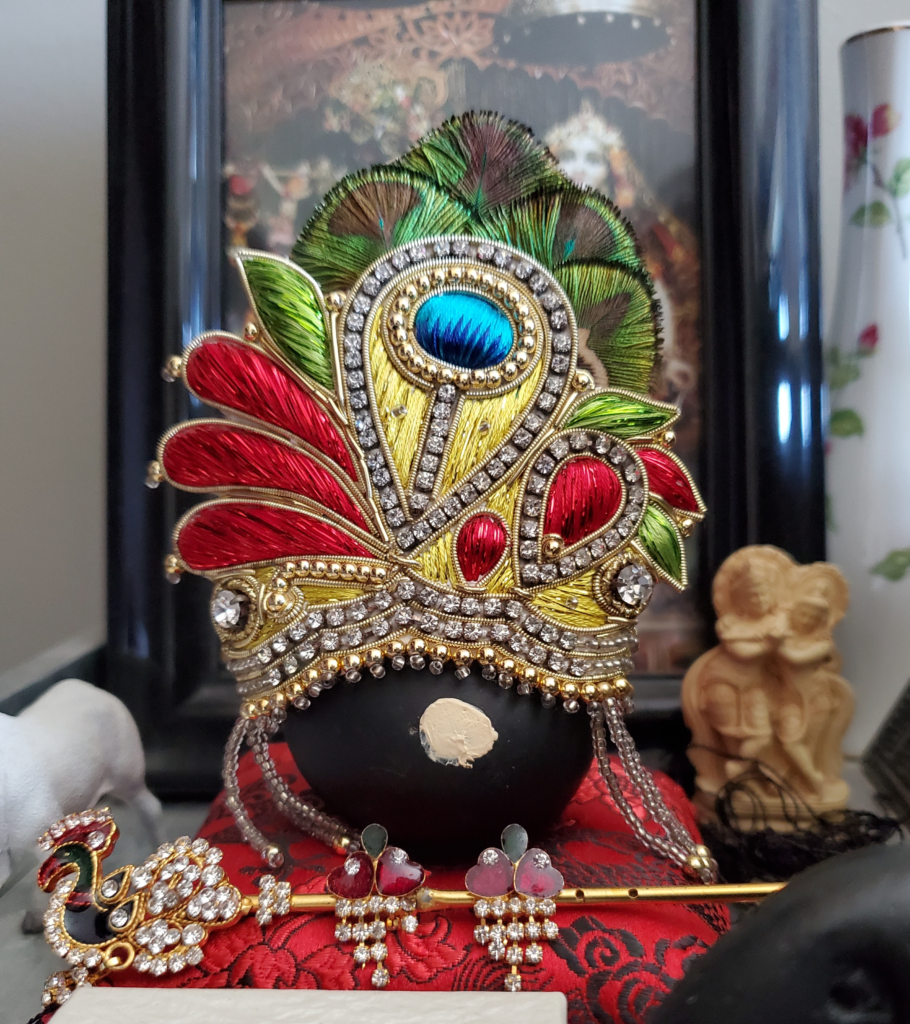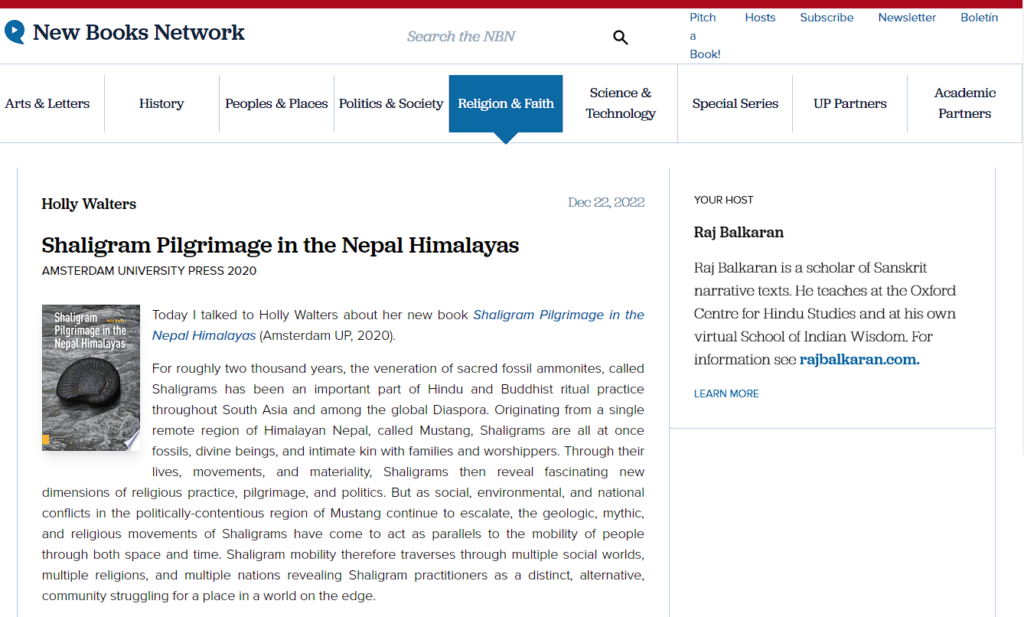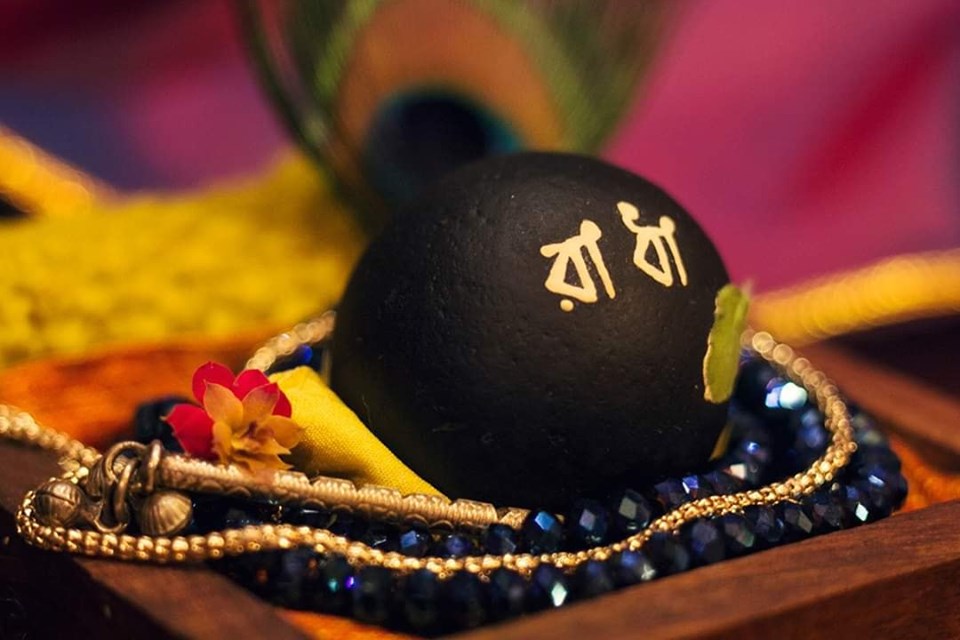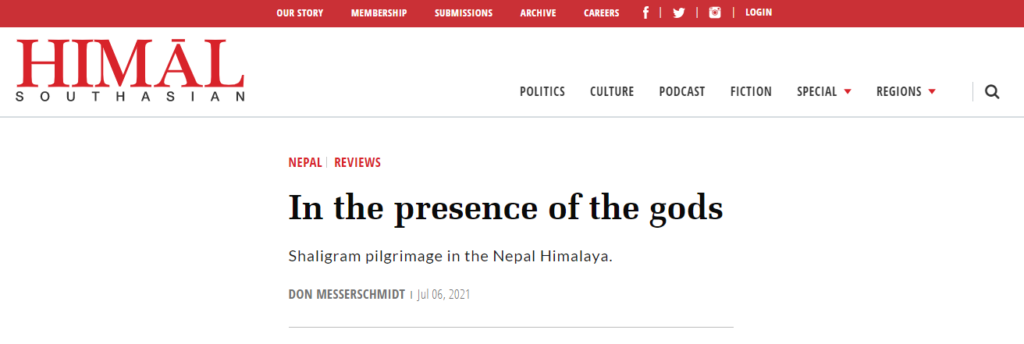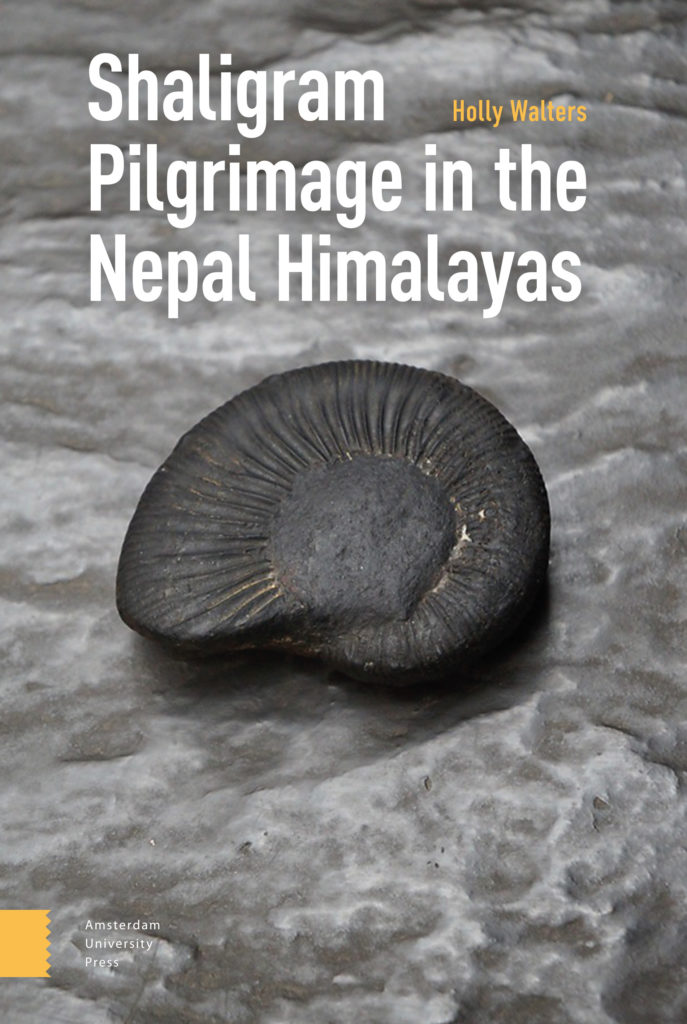“Yes, but what is it really?†The man pressed. “A fossil, or God?â€
Sitting in the domestic airport in Kathmandu, Nepal waiting on the day’s flights into the Himalayas was, I found, often fertile ground for impromptu research discussions. Since I was usually on my way to Mustang, where I was carrying out fieldwork on Shaligram stones; the sacred fossil ammonites revered by Hindus, Buddhists, and Bonpos the world over, it was not uncommon for trekkers or religious pilgrims to strike up conversations with me on the strange combinations of puja (ritual worship) paraphernalia and high-altitude hiking gear I typically carried.
“I mean,†the young Indian traveler went on to say, “the Vedas say that they (Shaligrams) are gods, but that’s just because they didn’t know what they actually were, right?â€
For anyone who spends any amount of time working with sacred fossils, especially Shaligram stones, they will quickly come to understand that in actual ritual practice, the categories of “fossil†and “deity†are not mutually exclusive, as might be anticipated in more Euro-American religious philosophies. In other words, that Shaligram practitioners do not necessarily see the fossil “being†of a Shaligram, along with the immense geological and temporal processes that go with it, as a challenge to the divine nature also present in the stones once they manifest in the Kali Gandaki River. In short, that Shaligrams are equally fossil and god and that these two categories are seen as complementary to one another rather than exclusionary.
But the question of “what are they really?†was a common one. At first, I took it as a revelatory question that demonstrated, for many people, a desire to be seen as modern and rational over superstitious and potentially backward. This was because people questioning me about my work wanted to know not only how I saw the Shaligram stones themselves but how I, and other Americans, saw Shaligram practitioners. For example, questioning whether or not non-Hindus and non-Buddhists could truly understand the divinity of the stones came up routinely as did questions about whether or not Americans thought that Indians and Nepalis were ignorant for “seeing God in the stone.†But then, as I began to think on it more and more, I came to realize that the core of the question, the true underlying implication of the word really, had less to do with fears of appearing uneducated and everything to do with the relationship between Shaligrams as scientific objects of study (i.e., ammonite fossils), as religious objects of worship (i.e., Shaligram deities), and as targets of pseudoscience. Essentially, just as the boundaries between “fossil†and “deity†had become blurry and indistinct, so too were the boundaries between “science,†“religion,†and “myth.†My subversion here of the “real†concepts of fossils and “non-real†concepts of gods and magic is also intentional because the boundaries between the two are what is ultimately at stake in conversations of pseudoscience.
Scholars often refer to the religious use of fossils, both historically and in contemporary periods, as fossil folklores (van der Greer et al, 2008). Generally, fossil folklores tend to refer to the use of otherwise ostensibly scientific phenomena; the preserved remains of prehistoric creatures in this case, for mythical or superstitious (read: fictional) ends. For example, the ways in which Young Earth Creationists and some fundamentalist Christians view the fossil record as devilish trickery rather than as products of deep geological time (IBSS 2019) or how “crystal magic†includes the occasional trilobite or bit of petrified wood along with various rare-earth minerals and salts. But in most cases, author’s, even religious authors, tend to take the overall position that their work is in conversation with the study of fossils and that “fossil†remains the default label. This is to say that, in the literature, they are really fossils first and divine second. But despite what we might argue in terms of taking ethnographic narratives seriously or how we might view this issue through competing cultural ontologies, my goal here isn’t to argue whether or not one side is ultimately correct over the other. Rather, what I note is a growing shift in public discourse from folklore to pseudoscience that is, at its core, a shift in models of knowing. Where myths and folklore once played important roles in social narrative, meaning-making, identity, and experience, they’ve now become the focal point for ontic reality and scientific positivism. Which is to say, that the boundaries between folklore and pseudoscience have been transgressed when the point of inquiry and discovery is no longer “what does it mean?†but “what is it really?†[i]
Crystal Magic and Saffron Science
In his book, The Philosophy of Science and the Occult, Patrick Grim argues that the role of pseudoscience, especially as it related to America and Europe in the Victorian Age, was as a label used to place social constraints on the creation and understanding of what constituted reality (1982: 131). In other words, that by calling something “pseudoscience,†one enacted a kind of cultural authority over an idea so as to regulate it to the fringes of acceptable discourse. To proclaim it “not real.†In modern America, I would argue that many academics continue to use the term similarly (for good and for ill) in what Massimo Pigliucci and Maarten Boudry call the “demarcation problem†(2013); a philosophical debate about the division between seeking the empirical reality of an object versus understanding the ways in which we think about the object (2013: 1). But this generally Western scientific approach tends to leave out some important other considerations especially as it relates to religious practices in South Asia. And that is the growing problem of saffron science.
Saffron science, according to Meera Nanda, is the “appropriation of modern scientific concepts and theories for the glories of the Vedas.†(2016: 2). Put another way, it is the drive to view all modern scientific discoveries, from robotics to nuclear physics to genetics and evolution, as having their true origins in Hindu sacred texts. This results, not surprisingly, in a fair amount of pseudoscientific thought designed to align the authority of scientific inquiry with right-wing political ideologies that claim India as an intrinsically Hindu homeland. In the US, many teachers and professionals will likely recognize very similar underlying political threads in the problem of Atlantis, Ancient Aliens, and Biblical literalism.
Shaligram stones are, unfortunately, not immune to either of these problems. I have encountered these rare fossils in a variety of contexts outside of their ritual ones, including in debates about their “true belonging†to specific Hindu traditions (and which proves these tradition’s antiquity and spiritual authority) over the claims of other religious groups as well as in New Age rock shops and in pagan-themed stores in the US and the UK where they are prized for their “magic†characteristics along with various amethyst and quartz crystals or other polished minerals. As such, what was originally a type of divine manifestation rooted in the landscapes of the high Himalayas and the creation stories of a variety of South Asian peoples has transformed into a pseudoscientific community in both America and South Asia that is more concerned with two particular problems. Firstly, that Shaligrams are really fossils (rather than aniconic deities) and secondly, that they are possessed of mystical properties that can bestow blessings on their owners. In other words, what was once a search for meaning in the narratives of the stones has become a debate about their ontological existence. The root of the problem has become, “but what are they really?†Regardless of your ultimate position on this subject, in the end, the point that I want to emphasize here is that science, pseudoscience, and religion are not quite so separate and exclusive as we like to believe. They are deeply, inextricably, intertwined.
What Can We Do?
Pseudoscience is never position neutral. It has an aim, even if that aim seems obscure. This means that combating pseudoscience in the classroom and in public discourse is going to have to take into account that many proponents of these kinds of theories are not necessarily arguing from either a position of good faith or from ignorance, but rather from an ideological or political position seeking social power and cultural control. In the classroom, I often translate this dynamic not into questioning a student’s particular faith-based ideal but into helping them uncover the motivations behind the belief. Where does this belief come from? Who does it serve? What is it about science that is being mistrusted here? And why? Pseudoscience is also not unique to Western discourses or even to Euro-American scientific models. It plays a role in political and social conflicts the world over. This means that an understanding of culture and belief systems, both ours and others, are integral to combating the desire to make into empirical reality what was once faith, community, and meaning. For all of us, it’s time to better ask the question, “what does it mean?†and not “but what is it really?â€
Bibliography
Grim, Patrick. 1982. Philosophy of Science and Occult, 1st Ed. SUNY Press.
Institute for Biblical and Scientific Studies (IBSS). “The Bible and Science: How Old is the Earth.†Accessed 6/9/2019. https://www.bibleandscience.com/science/ageofearth.htm
Nanda, Meera. 2016. Science in Saffron: Skeptical Essays on History of Science. Three Essays Collective.
Pigliucci, Massimo and Maarten Boudry eds. 2013. Philosophy of Pseudoscience: Reconsidering the Demarcation Problem. University of Chicago Press.
van der Geer, Alexandra and Michael Dermitzakis and John de Vos. 2008. “Fossil Folklore from India: The Siwalik Hills and the Mahâbhârata.†Folklore, Vol. 119, No. 1 (Apr., 2008), pp. 71-92. Taylor & Francis, Ltd.
[i] I am reminded, here, of the debate between Jeremy Bentham and Samuel Taylor Coleridge who argued similarly.


